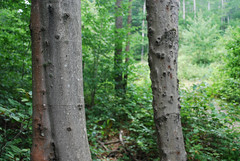 Beech bark disease causes lesions in the bark of American beech trees (Fagus grandifolia).
Beech bark disease causes lesions in the bark of American beech trees (Fagus grandifolia).
Photographer: Flickr user Eli SagorBeech bark disease has become a problem in North America since the early 1900s, and is slowly spreading throughout the eastern part of the United States, killing large American beech trees (Fagus grandifolia). Beech bark disease has been found as far south as North Carolina and Tennessee forests.1 2
It is a canker disease caused by an introduced fungus (Neonectria faginata or Neonectria ditissima) that enters trees through tiny wounds in the bark, killing patches of inner bark. The tree will die if enough cankers form, ringing the entire tree trunk.3
The wounds by which the fungus enters are created by a tiny, non-native yellow beech scale insect (Cryptococcus fagisuga) that inserts its needle-like mouth to feed on the inner bark. This scale should not be confused with the generally harmless beech blight aphid.
American beech plays an important role for wildlife, providing food—beechnuts—and den habitat for numerous animals.
There is currently no cost-effective way to manage this disease in a large forest stand. Fortunately, there are some American beech trees that seem to have less feeding injury from the beech scale. These resistant trees suffer less of an attack by the fungus. Over time, the offspring of these healthy trees may be able to replace the trees that succumb to beech bark disease.
- 1. . 2017. Major Forest Insect and Disease Conditions in the United States: 2015.
- 2. . 2008. Beech Bark Disease. Accessed 2018
- 3. . 2008. Forest Health Fact Sheet: Beech Bark Disease .


